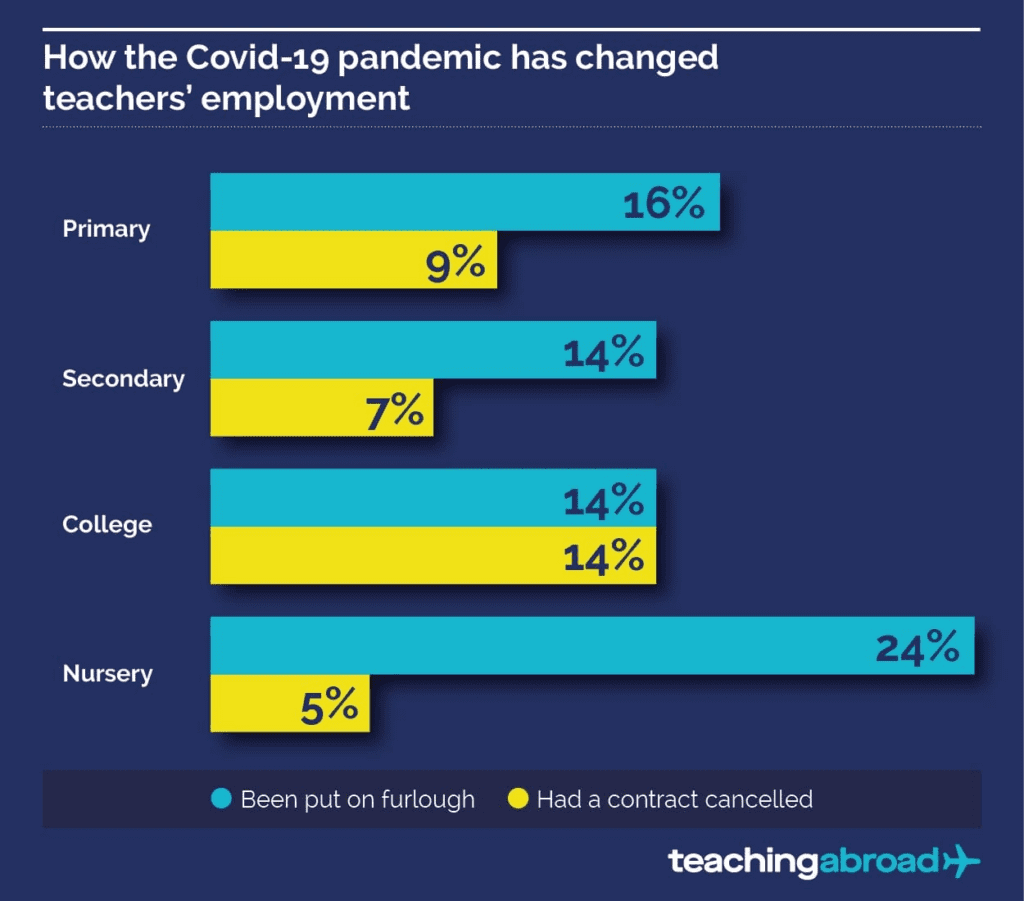1 in 4 Teachers Have Been Placed On Furlough Or Had Their Contracts Cancelled

How The #Coronavirus Has Affected Teachers
As the Government unveils more of its plans and guidance in the effort to re-open schools, Teaching Abroad Direct surveyed over 1,400 teachers to see how the COVID-19 pandemic has effected their employment and what changes would teachers like to continue being implemented, how their habits have changed and gauge their thoughts on what they think could happen next.
The results of Teaching Abroad Direct‘s survey found:
- Almost 1 in 4 teachers (23.8%) have been furloughed or had contracts cancelled as a result of the pandemic
- Supply teachers have been worst hit with 82% out of work or on furlough
- 2 in every 5 teachers admit they are financially worse off
- Teachers say the ideal class size should have no more than 15 students
- More than 3 in 5 teachers (63%) would welcome more home-based learning post-pandemic
- 69% of teachers believe parents don’t do enough to support their child’s learning
The COVID-19 lockdown globally has meant that students, teachers and parents have had to find ways of continuing education through a critical time of many countries’ school years.
But what has been the impact both on a personal and professional level for teachers and what changes would teachers like to continue being implemented as part of the ‘new normal’?
Teaching Aboard Direct’s survey found that almost a quarter (23.8%) of teachers have either been furloughed or had their contracts cancelled as a direct consequence of the pandemic.
Supply teachers have seen the biggest impact, with 82.5% being put on furlough or having their contracts come to an end. This is compared with 29.6% of part-time and just 17.9% of full-time teachers.
While fewer than 5% (4.5%) of full-time teachers have had their employment contracts cancelled, approximately 1 in 8 (13.3%) of those working full-time have been put on furlough.
Nursery school teachers have been the most likely to be placed on furlough, with almost 1 in 4 (24.4%) given a leave of absence. This high number of furloughed staff appears to be saving many from losing their employment, with just 4.9% of nursery school teachers having their contacts cancelled outright.
However, despite furlough being the preferred option, with 15.2% of educators being placed on a leave of absence, over 1 in 7 (14.3%) college educators and 9.4% of primary school teachers have seen their contracts cancelled.
Meanwhile, secondary school teachers appear to be the least affected by the pandemic, with just 1 in 5 (20.6%) being placed on furlough or having their employment cancelled; 6.9% have seen their contacts cancelled while just 13.7% have been placed on furlough.
Financially, 2 in every 5 teachers expect to be worse off as a result of the pandemic, with 30% expecting a financial hit anywhere up to £5,000. With starting salaries in the profession estimated at around £24,500, the pandemic could, therefore, see some teachers lose up to a fifth of their annual salary.
Over half (51.2%) of supply teachers expect to lose more than £2,500 during the pandemic, with 1 in 10 (9.4%) saying they expect to lose £10,000 or more. Meanwhile, full-time teachers are the most secure, with 64.5% believing that they won’t lose any earnings and a further 13.4% say they don’t expect to miss out on any more than £1,000.
Of the 1,144 teachers surveyed, 81% said they were now teaching remotely, with nursery (87.2%) and secondary (86.9%) school teachers the most likely to be working with their students from home, often by video conference calls and interactive workbooks and sheets.
College students appear to be the least likely to be remotely taught during the pandemic, with nearly 1 in 4 (22.58%) college teachers saying they aren’t teaching their students remotely.
When asked “What’s your opinion of remotely teaching students once lockdowns have been removed?” 48.2% of teachers said they suggested that while remote teaching needs some improvements, it could work as a longer-term measure, with a further 15.3% saying they’d be very happy to continue working remotely.
Overall, just 36.5% of teachers said remote teaching wouldn’t work in the long run, with female (37.8%) teachers the most likely to oppose.
Primary school teachers are the least likely to say they’d like to continue remote working after lockdown, with 40.6% saying it wouldn’t work. Unsurprisingly the trend in the responses showed that the older the children the more likely the teachers would be happy to work remotely, with almost three-quarters of college teachers (74.6%) saying that they would be happy to continue with the current setup or with some adjustments in the future.
The results also highlight how the responses vary by age, with teachers aged 18-24 (73.1%) being more receptive to increased remote working than those aged 25-34 (61.7%), perhaps highlighting how those new to the profession are less constrained by traditional methods of classroom teaching and more open to flexible working moving forward.
Interestingly, and in a blow to many parents who will have had to juggle professional and family commitments during lockdown, 68.8% of teachers said they didn’t think parents were doing enough to support their child’s education at home, with almost 3 in 4 (74.4%) secondary school teachers agreeing that parents don’t do enough, closely followed by college teachers (71.4%).
With the challenge of social distancing a key concern within the post-lockdown school environment, there is a strong possibility that class sizes will need to be reduced as a result. And according to the results from the survey, this would be welcomed by the majority of teachers, who have stated that their ideal class size would consist of, on average, 15 students.
However, over 1 in 4 (27%) feel class sizes should be even lower, ranging between 1 and 10 pupils. Female teachers are 18.4% more likely to feel classes should consist of 10 or fewer students, compared to their male counterparts, with a third (33.3%) expressing classes should be more than halved compared to OECD latest data on class sizes.
Andrew Lynch, Director of Teaching Abroad Direct, comments:
“Clearly teachers have worked tirelessly during the Coronavirus pandemic, adjusting how they work during the introduction of social distancing and the recent lockdowns, with many making their classes available remotely; ensuring students are able to continue their education.”
“As Governments look to re-open their economies and, in turn, their schools, we hope that teachers are listened to both in how to implement social distancing in schools and how to improve the remote learning experience for both teachers and their students.”
Methodology: To conduct our study, we surveyed 1,144 teachers globally across a range of sectors, age-groups and backgrounds.
Respondents were asked how they had been impacted by the Covid-19 pandemic in terms of their day-to-day job and changes in their routine as a consequence of teaching remotely.
The audience included a breakdown of the following: 52% of respondents were aged between 25-34; 21% between 35-44; 14% 45-54; 7% between 18-24; 5% between 55-64; and 1% over 65. 68% of respondents were female and 32% male.











Responses